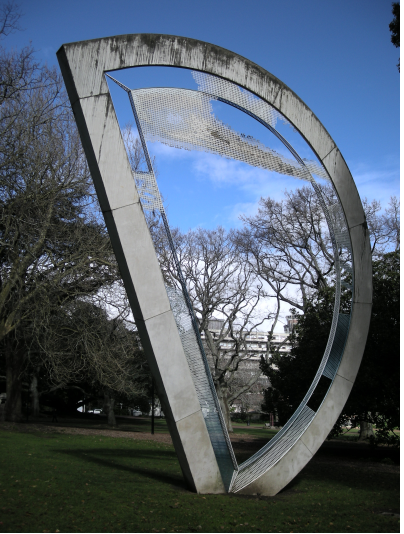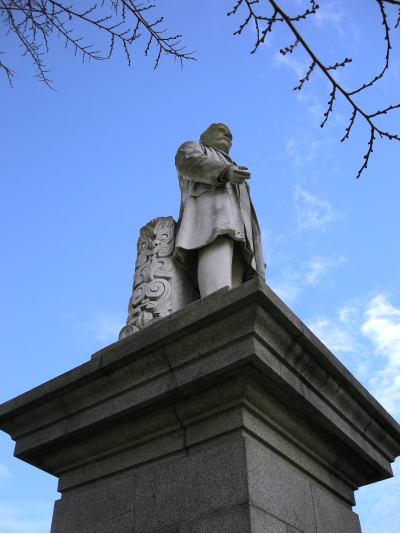AWA: Academic Writing at Auckland
Title: Art work in Albert Park: An analysis
|
Copyright: Anna Chilcott
|
Description: Short analysis of two works of art, appropriateness for context, both in terms of architectural/spatial setting and social role there. Which of the two works is most successful for the venue and why?
Warning: This paper cannot be copied and used in your own assignment; this is plagiarism. Copied sections will be identified by Turnitin and penalties will apply. Please refer to the University's Academic Integrity resource and policies on Academic Integrity and Copyright.
|
Writing features
|
Art work in Albert Park: An analysis
|
Commissioned in 1988 to commemorate the Auckland Art Gallery centenary, Neil Dawson's contemporary sculpture Throwback is a key feature of the south-western side of Auckland's Albert Park. Made of concrete and stainless steel,[1] the semi-circular shape of the sculpture is reminiscent of a window through which the landscape can be viewed from multiple angles. The edge of one entire side of Throwback is sculptured to appear like the ledge surrounding a window which also adds to this idea, while the steel, cut to look like a fine mesh, perhaps implies the glare of sunlight off glass. The rounded ridges on the south-east side of Throwback could also be considered archivolts; these line the sculpture and further create the illusion of a portal through which the viewer can see not only the park but also the Art Gallery and high rises of the city beyond. The material used to construct Throwback is not only reflective of the city environment which surrounds the park, but it creates a juxtaposition between nature and the hard, sharp lines of the man-made work. Throwback does not dwarf the natural landscape around it, but instead competes with it, towering high above ground level so that it must be viewed from a distance to get an idea of the piece's full scale. The placement of the sculpture away from the footpath ensures this. “The creation of spacial illusion is basic to Dawson's art”[2] and this is clear by the way he has created Throwback in such a way that it engages in a discussion with the space around it. Dawson's architectural style combined with the way his materials mimic those used to construct the Art Gallery nearby, means that Throwback sits within the space as if an extension of the gallery itself.
The statue of Sir George Grey by the Victorian sculptor Francis J. Williamson is one of many pieces of memorial artwork found in Albert Park. Commissioned in 1902 to commemorate Grey's death in 1898, the sculpture stands in the north-west corner of the park facing two nineteenth century cannons and a memorial dedicated to the New Zealand soldiers who lost their lives during the South African Wars of the early twentieth century. Williamson, a sculptor to Queen Victoria herself,[3] created the first statue of the Queen to be erected in New Zealand, also located nearby in Albert Park. The finely crafted statue of Grey stares out toward the city, his expression completely void of any emotion. The folds of drapery which make up his clothing also lack expression, and the energy usually associated with a man of Grey's position seems absent from the representation, making the sculpture seem flat and lifeless. This lack of character is only amplified by the smooth stone used in the creation of the sculpture. Prior to the settlement of Europeans in Auckland, Albert Park was home to the Maori village of Rangipuke. These ties can be seen, albeit on a diminutive scale, represented by the carving situated at Grey's rear. The sculpture is large in scale and looms over the footpath situated close to the base of the pedestal which reads: “Soldier, Statesman, Lover of his Fellowmen, whose wisdom, eloquence, and strong personality gave to the people of this colony a large measure of the liberties they now possess.” Originally positioned on Queen Street, the statue was considered a hazard to traffic and was moved in 1922 to its current position in Albert Park. Later controversy surrounding the Treaty of Waitangi lead to the statue being beheaded on Waitangi Day 1987, meaning that a new head had to be created by local artist Roderick Burgess. Further vandalism of the statue followed.[4] In conclusion, while Throwback commemorates the first permanent art gallery in New Zealand and, thus, may represent what might be considered the true establishment of the colony, the statue of Governor Grey represents a significant period, not only in the history of Auckland City, but in the history of New Zealand as a whole. As a commemorative piece, it represents a turbulent series of events involving a loyal British subject who, among other achievements listed around the base of his statue, was the Governor of New Zealand from 1845 – 1853 and 1861 – 1868, and who had a crucial role to play in the establishment of the city of Auckland. His donation of more than 200 rare and exotic plants to the park in 1882 has shaped the way we see Albert Park as it is today. Whether viewed as positive or negative, the impact Sir Grey had on the history of Auckland undoubtedly makes the 1902 sculpture of his likeness far more appropriate to the context of Albert Park than the more contemporary Throwback. Bibliography Auckland Art Gallery, The Collection 'Neil Dawson Throwback' http://www.aucklandartgallery.com/the-collection/browse-artwork/7649/throwback Consulted 26 September 2010. Auckland City Council, Parks in Auckland 'Albert Park' http://www.aucklandcity.govt.nz/whatson/places/parks/albertpark.asp, Consulted 26 September 2010. Auckland City Council, A guide to Albert Park. Date unknown. Brown, Warwick. Another 100 New Zealand Artists. New Zealand: Godwit Publishing Ltd, 1996. Dunn, Michael, New Zealand Sculpture: A History. New Zealand: Auckland University Press, 2002. Paton, Justin. Inner Landscapes: 15 New Zealand Artists with Canterbury Connections. New Zealand: Canterbury University Press, 2009. University of Auckland Business School, The University Heritage Trail:Architectural and Historical Attractions, 2005. [1] Auckland Art Gallery, The Collection 'Neil Dawson Throwback' http://www.aucklandartgallery.com/the-collection/browse-artwork/7649/throwback Consulted 26 September 2010. [2] Warwick Brown. Another 100 New Zealand Artists. (New Zealand: Godwit Publishing Ltd, 1996). [3] Michael Dunn, New Zealand Sculpture: A History (New Zealand: Auckland University Press, 2002), 21. [4] Ibid. |
|


